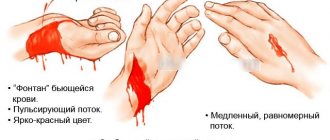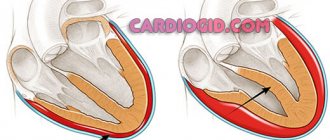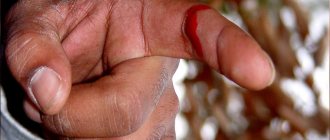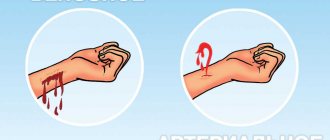What is arterial bleeding?
Arterial bleeding is a type of bleeding that comes from damaged arteries. These vessels carry oxygenated blood to all corners of our body, so failure of large vessels of this type can be fatal.
It is necessary to act immediately in case of such blood loss, because high pressure in the arteries causes blood to flow out at high speed. Often the count goes by minutes and even seconds.
Differences between arterial and venous bleeding
What is characteristic of arterial bleeding?
The main sign of arterial bleeding is a rapid flow of scarlet blood from the wound. When bleeding from veins, the blood is darker in color and flows slowly, since the pressure in these vessels is much lower.
Arterial bleeding has characteristic signs by which it can be easily recognized:
- The leaking blood is bright scarlet in color and flows at a considerable speed,
- The blood is quite liquid, in contrast to the thick venous,
- The blood stream “pulsates” in rhythm with the heartbeat,
- The pulse in the areas of the damaged artery located below the wound is weakly felt or absent,
- The victim’s well-being worsens before our eyes: the person feels dizzy, loses strength, may lose consciousness,
- The skin quickly becomes pale and acquires a bluish tint.
If the carotid artery is injured, the victim's life is in great danger. This is one of the main vessels that supplies blood to the brain. Without first aid, a person will die in a couple of minutes, so you should definitely know how to stop bleeding.
What can cause bleeding?
In the clinic, there are two types of bleeding: from mechanical or pathological damage. The first indicates trauma to the vessel wall due to fractures of nearby bones or injury from any object.
Pathological ones occur when the arterial wall is destroyed due to its structural changes. This phenomenon may be the result of a tumor process in the vessels, or occur due to vasculitis and other systemic diseases.
Common causes of bleeding from the arteries include:
- Injuries resulting from road accidents.
- When an artery is damaged, the cause of bleeding does not play a major role. In any case, it is necessary to provide first aid as quickly as possible and contact qualified specialists.
- Different types of hemophilia.
- Liver cirrhosis, hepatitis.
- Diabetes.
- Vascular damage caused by bacterial toxins and viral infections.
When a large artery is damaged, centralization of blood circulation occurs - a condition in which blood moves away from the extremities, concentrating in the area of vital organs - lungs, brain, heart. This is a physiological phenomenon aimed at emergency life support. It manifests itself as pallor and cyanosis of the extremities, which cease to be supplied with blood as usual.
Why is arterial bleeding most dangerous?
Arterial blood is the main supplier of oxygen to all organs.
Serious blood supply threatens ischemia, that is, oxygen starvation, of certain parts of the body. Organs like the intestines can go without air for tens of minutes, but irreversible changes occur in the brain and heart after just 6 minutes of fasting.
There is also such a thing as collapse - a condition in which hemorrhagic shock occurs due to a sharp drop in blood pressure and blood flow volume. It can lead to cardiac arrest.
Causes of blood loss
What can lead to such a pathology? Bleeding may be caused by mechanical trauma. And sometimes it occurs due to destruction of the vascular wall.
In medicine, the following reasons are identified.
- Traumatic injuries. The sources can be thermal (for example, due to a strong temperature difference), mechanical factors (bone fracture, bruise, wound).
- Vascular diseases, tumors. Diseases such as hemangiosarcoma and atherosclerosis can lead to the above-mentioned bleeding. Sometimes the pathology is provoked by a purulent tissue lesion in which the vessels are involved.
- Blood clotting disorders, liver diseases. The most dangerous diseases are the following: hemophilia, fibrinogen deficiency, von Willebrand disease, hepatitis, cirrhosis, hypovitaminosis K.
- Common ailments. A similar pathology can be provoked by diabetes mellitus, vitamin deficiency, infections (sepsis, viruses) or poisoning.
How can you stop bleeding?
Several techniques are used to stop bleeding. It is worth choosing one of them depending on the location of the damaged vessel, its size, and the intensity of the hemorrhage.
These are the techniques:
- Finger compression of the vessel,
- Application of a tourniquet,
- Wound tamponade.
Pressure points of arteries
The first and last methods of stopping are suitable if the carotid, maxillary or temporal arteries are damaged, that is, those vessels on which it is impossible to apply a tourniquet. Arterial bleeding from wounds of the extremities can most effectively be stopped using a tourniquet.
Extensive wounds
In this case, the rules for stopping arterial bleeding are somewhat different. The best method, available in any conditions, is to clamp the vessel slightly above the wound (a place located along the bloodstream closer to the heart). However, it is necessary to know exactly in which area the damaged artery is closest to the surface. This is where the vessel should be pressed against the bone.
Such an area can be identified by its characteristic pulsation. Once the point is found, it should be pressed down firmly. For such purposes, one finger is not enough. Clamping occurs with the entire palm or even a fist. If everything is done correctly, arterial bleeding stops immediately.
However, it is very difficult to clamp the artery for even 15 minutes. And when transporting the victim, this may become impossible. Therefore, the above method is temporary. It makes it possible to treat the wound and prepare the necessary material to stop bleeding in other ways.
How to provide first aid correctly?
Timely provision of first aid for profuse arterial hypertension often determines whether the victim will remain alive. To quickly provide assistance, it is worth knowing what to do in this situation. First of all, call an ambulance, and then immediately begin following the recommended course of action.
Stop bleeding point by point
- Decide on a method to stop the bleeding. As mentioned above, depending on the location of the injury, you can simply pinch the vessel with your fingers, apply a tourniquet, or tamponade the wound.
- First aid will help the victim wait for the ambulance to arrive. After which the bleeding will be completely stopped by ligating the vessel or suturing the wound.
- First, try to squeeze the artery with your fingers. The vessel should be pressed not against soft tissues, but against the bone, to ensure effective stopping of bleeding.
- If localization allows, apply a tourniquet slightly higher from the site of vessel damage.
- If it is not possible to apply a tourniquet, tamponade the wound.
Brachial artery
The closest point lies between the shoulder muscles.
- The victim's hand should be raised or placed behind his head.
- It is more convenient to be behind the patient.
- The vessel is clamped with four fingers from the outside or from the inside.
- The depression between the muscles below the shoulder joint is felt at 1/3 of the shoulder and this place is firmly pressed against the bone.
Pressing the brachial artery from the front (a) and back (b) positions
How should a vessel be clamped during arterial bleeding?
To provide assistance with blood loss as quickly as possible, you need to know what actions to perform during digital compression and in what order.
In an extreme situation, try to concentrate and follow this algorithm:
- Find the wound. If it is not visible due to blood, you need to apply pressure with your palm. This way you can determine exactly where the “fountain” is coming from and better cover the wound.
- Remove clothing from the injured area.
- If the bleeding is coming from a vessel on your arm, press it against the nearest bone with your thumb and use your other finger to grasp and squeeze your hand.
- Hold the wound for 10 minutes. This time is most often enough to stop mild to moderate bleeding.
- Do not remove your fingers until the tourniquet is applied.
Finger pressure
It is advisable to disinfect your hands with soap or antiseptic before performing clamping. This way you can avoid infection in the wound. However, in a situation where there is a serious threat to the life of the victim, this advice can be safely ignored.
Places of compression of the main arteries:
| Artery name | How to find | Bone to press |
| Temporal | 2 cm superior and anterior to the opening of the external auditory canal | Temporal |
| Facial | 2 cm anterior to the angle of the mandible | Lower jaw |
| General sleepiness | Superior edge of the thyroid cartilage | Carotid tubercle of the transverse process of the 6th cervical vertebra |
| Subclavian | Behind the collarbone in the middle third | First rib |
| Axillary | Anterior border of hair growth in the armpit | Head of humerus |
| Shoulder | Medial border of the biceps muscle | Inner surface of the shoulder |
| Femoral | Middle of the inguinal fold | Horizontal ramus of the pubis |
| Popliteal | Top of the popliteal fossa | Posterior surface of the tibia |
| Abdominal aorta | Navel area (pressed with fist) | Lumbar spine |
What are the signs of other bleeding?
● Venous bleeding
- blood from the damaged vein flows out in a weak, continuous stream of dark red color (the color of venous blood determines its saturation with carbon dioxide). This type of bleeding is less dangerous for the wounded, although it can be quite profuse. Such bleeding can easily be stopped by applying a pressure bandage.
● Capillary bleeding
- blood oozes out like from a sponge, in drops. At the same time, the entire wound bleeds. Such bleeding stops on its own or after applying a small pressure bandage and has no dangerous consequences for the victim.
● Parenchymatous
called bleeding from damaged internal (parenchymal) organs - liver, kidneys, spleen. Since there are many small arteries, veins and capillaries in the internal organs, parenchymal bleeding can be prolonged and profuse, and the entire wound surface bleeds.
● If bleeding occurs through a wound to the outside, then such bleeding is called external, and if blood flows into tissues (organs) or some body cavity (thoracic, abdominal), then it is called internal.
Internal profuse bleeding is characterized by the following signs: the wounded person is very pale, covered in cold sweat, feels very thirsty, yawns, the pulse is rapid, weak, barely palpable, and sometimes disappears completely.
First medical aid for this bleeding: rest, cold on the chest and abdomen, careful carrying on a stretcher, immediate delivery of the victim to the ship's infirmary, or a shore-based medical facility.
The human body is penetrated by many vessels that contain a multifunctional fluid - blood. Throughout life, it is influenced by many factors, among which traumatic effects are the most common. Bleeding often occurs after it. It is important to be able to correctly characterize the signs of the victim’s condition in order to provide him with the necessary assistance. And if there is arterial bleeding, then save his life.
Actions when applying a tourniquet
A tourniquet is a more reliable way to stop bleeding than clamping an artery. It is applied in cases of moderate and severe hemorrhages 2 cm above the damaged area.
The tourniquet can be medical, that is, pre-made. However, in emergency situations, most often this device can be replaced with improvised means such as a belt, strips of strong fabric, or a tie.
When choosing an item to bandage, make sure it is as wide as possible. Thin ropes are not suitable for making a tourniquet, as they compress the tissue too much, promoting the development of necrosis.
The tourniquet is not applied to the skin. To avoid pinching too much, place a piece of fabric under it or simply fasten it to the patient’s clothing. The criterion for correct application of a tourniquet is the absence of a pulse in the compressed vessel below the point of application.
It is worth remembering that the tourniquet cannot be applied for a long time. In summer, you can fix the vessel for 60 minutes, in winter – 30 minutes. To help emergency physicians, write a note with the exact time to clamp the artery, secure it with a tourniquet, or pin it to your clothing. If paper is not available, write a note on the victim's skin.
After the recommended clamping time has passed, the tourniquet should be removed for 10 minutes. This helps to avoid tissue necrosis as a result of oxygen starvation.
Applying a tourniquet for arterial bleeding
The application of a tourniquet to the carotid artery has a number of features. In order not to crush the vessel on the opposite side, it is necessary to raise the victim’s hand on the side opposite to the location of the wound. You can also use any strong stick, after placing a cotton-gauze roller between it and the skin.
Secure the artery with a tourniquet, also wrapping it around the splint (stick or hand). Bleeding in the neck is very difficult to stop, so try to secure the tourniquet well.
How is a hemostatic tourniquet applied?
PULL THE TURNINESS BY THE LIMB AND STRETCH IT WITH MAXIMUM EFFORT.
PRESS THE FIRST TURN AND MAKE SURE THERE IS NO PULSE. APPLY THE FOLLOWING TURNINGS WITH LESS FORCE.
WRAP THE LOOP AROUND THE HARNESS AND SECURE IT.
PLACE A NOTE ABOUT TIME TO APPLY THE TURNINE UNDER THE ELASTIC LOOP
.
ATTENTION!
A TURNING CAN BE APPLIED ON A LIMB FOR NO MORE THAN 1 HOUR!
IF YOU DON'T HAVE A HARNESS, YOU CAN USE A BELT, A SCARF, OR A TWIST WITH A STICK
.
IN CASES OF BLUE INDUCTION AND SWELLING OF THE LIMB (IN IMPROPER APPLICATION OF THE TURNINESS), THE TURNINESS SHOULD BE IMMEDIATELY REAPPLIED.
Tourniquet around the neck
applied without monitoring the pulse and left until help arrives.
To seal the wound, use multi-layered tissue (for example, a package of sterile bandages or rolled up clothing).
Tourniquet on the thigh
applied through a smooth hard object (bandage) with pulse control in the popliteal
How is wound tamponade performed?
Tamponade and tourniquets can stop serious bleeding, but they are only temporary measures. Only qualified health workers can finally cope with the situation.
How to stop bleeding if it is impossible to apply a tourniquet? In such cases, tamponade is necessary.
To do this, you will need a bandage or cotton wool; if they are unavailable, ordinary paper napkins will do.
Fold cotton wool or napkins in several layers, press them to the wound, wrapping them tightly with a bandage. A tampon of this type is used for hemorrhages from the arteries of the upper and lower extremities.
To make stopping the bleeding more effective, elevate the affected limb.
Actions in case of large blood loss
The most bloodthirsty artery is the carotid artery. It is vital, and its damage is very often fatal. If you manage to stop bleeding from such a major vessel, it is worth taking measures to prevent hypovolemic shock (hypovolemia is a condition in which the volume of blood flow sharply decreases).
The victim should be provided with access to air. Remove his excess clothing. Lay him on his back, try to put his legs on an elevation so that the blood is concentrated as much as possible in the central part of the body.
If the victim is conscious, give him some water or sweet tea. If you lose consciousness and there are no breathing movements, perform an indirect cardiac massage.
In cases of acute blood loss, try to calm the victim so that he does not make unnecessary movements. Wait for the ambulance to arrive, which you need to call before providing first aid. Tell the dispatcher the address of the incident and immediately begin to stop the bleeding.
Carotid artery
Pressure of the carotid artery is required for bleeding from the vessels of the head, submandibular region, and upper neck. The situation is complicated by the impossibility of applying a circular pressure bandage to the neck, because the victim will suffocate.
Therefore, pressing is carried out on the wounded side with the thumb, when the rest are located on the back of the victim’s head, or with four fingers when approaching from behind. It is important to take into account the direction of the blood through the carotid artery: it is clamped below the site of injury.
In these ways the carotid artery is pressed
The desired point is located in the middle of the anterior surface of the neck muscle. Turn the wounded person's head in the opposite direction and it will be clearly visible. The artery is pressed against the spinous processes of the vertebrae.











